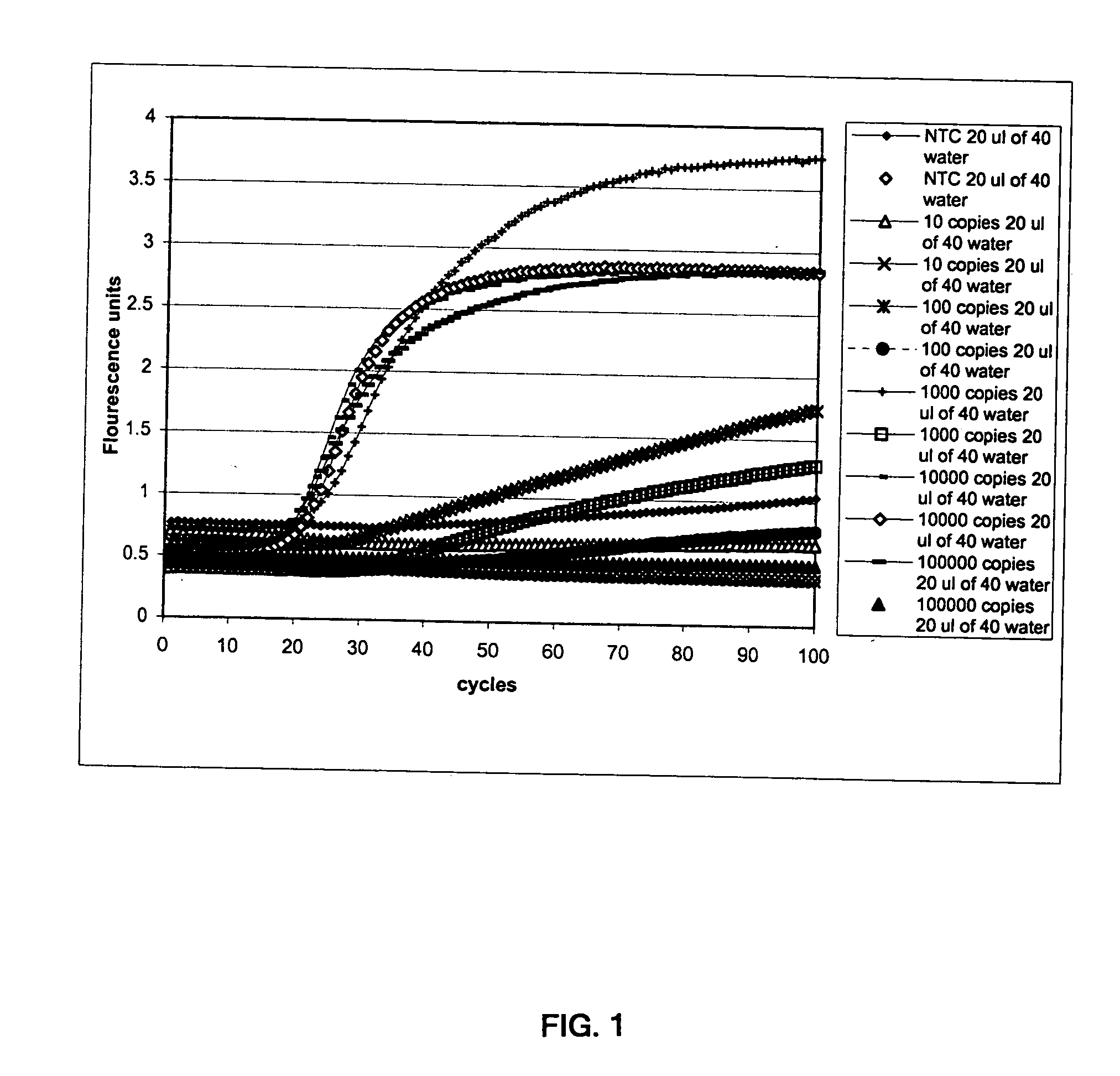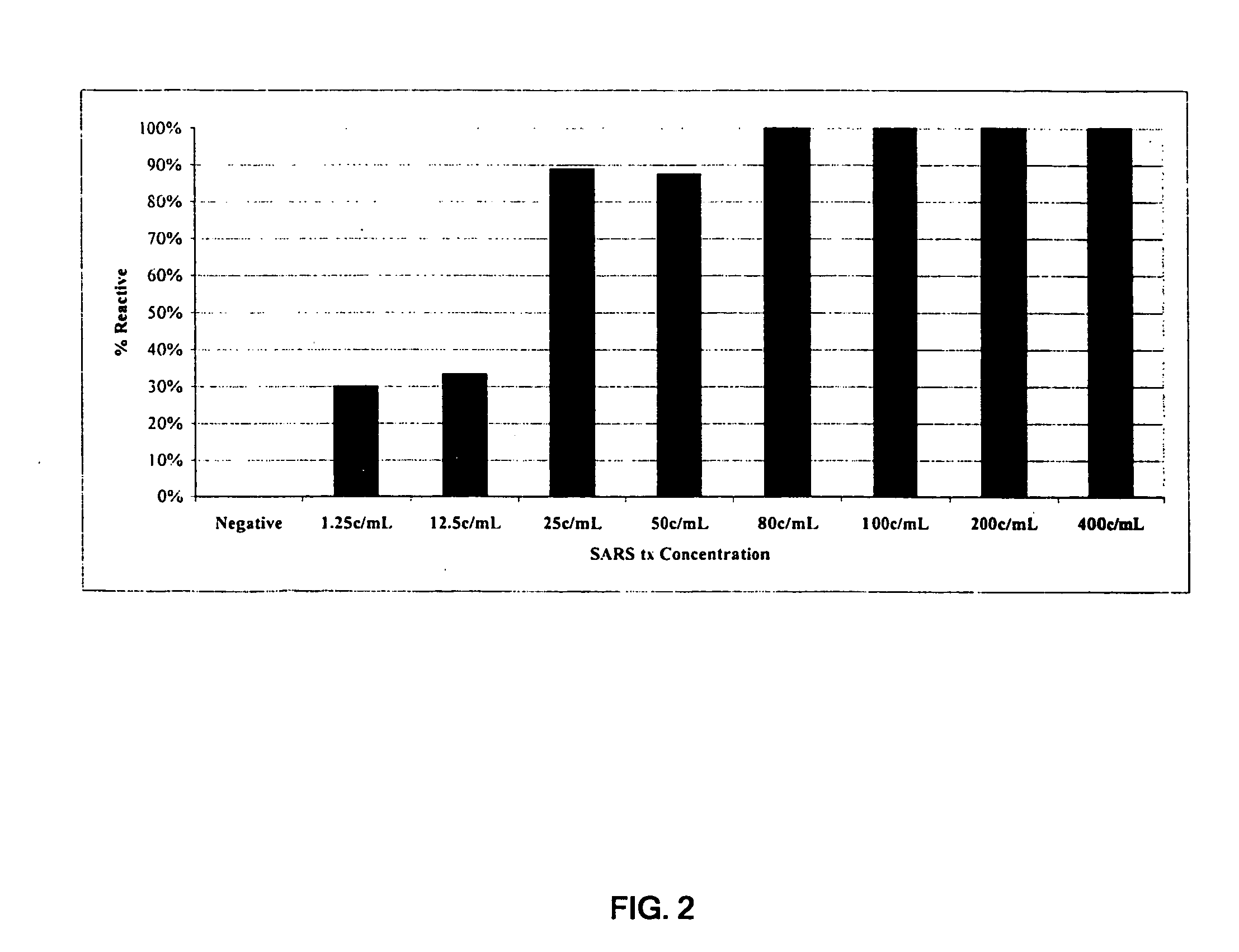Compositions and methods for determining the presence of SARS coronavirus in a sample
a technology of sars coronavirus and composition, which is applied in the field of composition and methods for determining the presence of sars coronavirus in samples, can solve the problems of low sensitivity of these initial pcr tests, inadequate antibody tests, and high fatality rate among patients, so as to minimize the reduction of sensitivity, enhance the sensitivity of the method, and reduce the effect of mutation ra
- Summary
- Abstract
- Description
- Claims
- Application Information
AI Technical Summary
Benefits of technology
Problems solved by technology
Method used
Image
Examples
example 1
Sensitivity of Real-Time SARS-CoV Assay
[0155] In this experiment, we tested the sensitivity of a SARS-CoV assay system targeting a SARS-CoV RNA transcript mapping to the replicase gene (“the trancript”). The assay system included a target capture step for isolating the transcript (see Weisburg et al., U.S. Pat. No. 6,110,678), an amplification step employing two sets of primers and promoter-primers in a Transcription-Mediated Amplification (TMA) procedure (see Kacian et al, U.S. Pat. No. 5,399,491), and a detection step for detecting the production of amplicon with a molecular beacon probe in real-time (see Tyagi et al., U.S. Pat. No. 5,925,517). The oligonucleotides of this experiment were synthesized using standard phosphoramidite chemistry, various methods of which are well known in the art. See, e.g., Caruthers et al., Methods in Enzymol., 154:287 (1987). Oligonucleotide synthesis can be or was performed using an Expedite™ 8909 Nucleic Acid Synthesizer (Applied Biosystems, Fost...
example 2
Specificity and Sensitivity of SARS-CoV Assay
[0160] This experiment was designed to evaluate the specificity and sensitivity of a SARS-CoV assay system targeting a SARS-CoV RNA transcript mapping to the replicase gene (“the trancript”). Viral nucleic acid from human coronavirus strain 229E (“HcoV”), human immunodeficiency virus (“HIV”), hepatitis C virus (“HCV”), hepatitis B virus (“HBV”), and parvovirus were included to assess the cross-reactivity of this assay system. The assay system included the capture probe, target capture reagent, materials, instrumentation, and protocol of Example 1, an amplification step employing the primer / promoter-primer sets of Example 1 in a TMA reaction, and a detection step for detecting the production of amplicon with an acridinium-ester (AE)-labeled probe in a Hybridization Protection Assay (Arnold et al., U.S. Pat. No. 5,283,174). As above, the oligonucleotides of this experiment were synthesized using standard phosphoramidite chemistry, various ...
PUM
| Property | Measurement | Unit |
|---|---|---|
| temperature | aaaaa | aaaaa |
| Tm | aaaaa | aaaaa |
| Tm | aaaaa | aaaaa |
Abstract
Description
Claims
Application Information
 Login to View More
Login to View More - R&D
- Intellectual Property
- Life Sciences
- Materials
- Tech Scout
- Unparalleled Data Quality
- Higher Quality Content
- 60% Fewer Hallucinations
Browse by: Latest US Patents, China's latest patents, Technical Efficacy Thesaurus, Application Domain, Technology Topic, Popular Technical Reports.
© 2025 PatSnap. All rights reserved.Legal|Privacy policy|Modern Slavery Act Transparency Statement|Sitemap|About US| Contact US: help@patsnap.com


